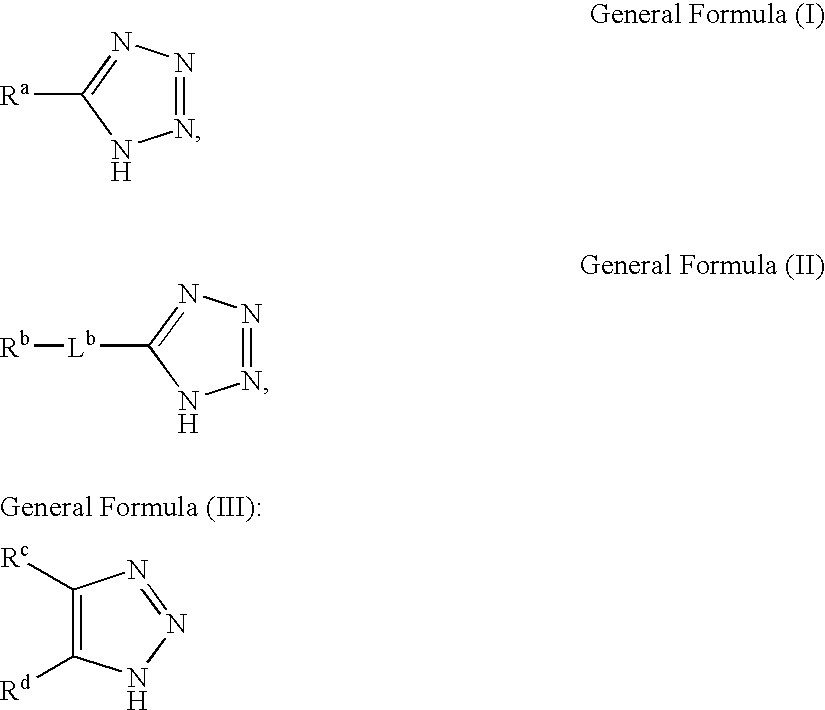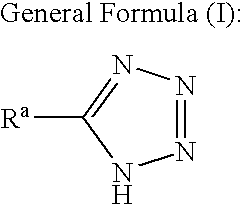Polishing liquid for metals
a technology for polishing liquid and metals, applied in the direction of electrical equipment, chemical equipment and processes, other chemical processes, etc., can solve the problems of excessive polishing of the whole surface of the metal substrate to be processed, inability to achieve satisfactory polishing speed, scratch marks, etc., to improve the selectivity of the polishing step, improve the speed of the chemical/mechanical polishing step, and improve the effect of surface flatness
- Summary
- Abstract
- Description
- Claims
- Application Information
AI Technical Summary
Benefits of technology
Problems solved by technology
Method used
Image
Examples
example 1
[0117]A metal-polishing liquid (the metal-polishing liquid of Example 1) was prepared on the basis of the formulation (metal-polishing liquid 1). The resulting metal-polishing liquid was evaluated by subjecting the same to tests of polishing metals according to the following method.
(Metal-Polishing Liquid 1)ComponentAmountHydrogen peroxide (oxidizing agent)5g / LGlycine (organic acid)0.2mol / LCompound I-1 (a specific tetrazole derivative)0.2mmol / LColloidal silica (abrasive grains)9g / LPure waterAd. 1000mLpH (adjusted using aqueous ammonia and6.7sulfuric acid)
(Test of Polishing Metals)
[0118]Polishing Pad: IC 1400XY-K Groove (available from Rodhel Company)
[0119]PolishingApparatus: LGP-612 (available from LapmaSterSFT Company)
[0120]Presser Pressure: 75 g / cm2
[0121]Feed Rate of Polishing Liquid: 200 mL / min
[0122]Copper-Blanketed Wafer: A wafer on which a copper film is deposited in a thickness of 1.4 μm (diameter: 200 mm)
[0123]Tantalum-Blanketed Wafer: A wafer on which a tantalum film is dep...
example 6
[0132]A metal-polishing liquid (the metal-polishing liquid of Example 6) was prepared on the basis of the formulation (metal-polishing liquid 2). The resulting metal-polishing liquid was evaluated by subjecting the same to tests of polishing metals according to the following method.
(Metal-Polishing Liquid 2)ComponentAmountHydrogen peroxide (oxidizing agent)5g / LGlycine (organic acid)15.0g / L(0.2mol / L)Compound III-1 (specific 1,2,3-triazole derivative)0.2mmol / LColloidal silica (abrasive grains)9g / LPure waterAd. 1000mLpH (adjusted using aqueous ammonia and6.7sulfuric acid)
(Test of Polishing Metals)
[0133]Polishing Pad: IC1400XY-K Groove (available from Rodhel Company)
[0134]Polishing Apparatus: LGP-612 (available from LapmaSterSFT Company)
[0135]Presser Pressure: 75 g / cm2
[0136]Feed Rate of Polishing Liquid: 200 mL / min
[0137]Copper-Blanketed Wafer: A wafer on which a copper film is deposited in a thickness of 1.4 μm (diameter: 200 mm)
[0138]Tantalum-Blanketed Wafer: A wafer on which a tantal...
PUM
| Property | Measurement | Unit |
|---|---|---|
| Dissociation constant | aaaaa | aaaaa |
| Dissociation constant | aaaaa | aaaaa |
| Dissociation constant | aaaaa | aaaaa |
Abstract
Description
Claims
Application Information
 Login to View More
Login to View More - R&D
- Intellectual Property
- Life Sciences
- Materials
- Tech Scout
- Unparalleled Data Quality
- Higher Quality Content
- 60% Fewer Hallucinations
Browse by: Latest US Patents, China's latest patents, Technical Efficacy Thesaurus, Application Domain, Technology Topic, Popular Technical Reports.
© 2025 PatSnap. All rights reserved.Legal|Privacy policy|Modern Slavery Act Transparency Statement|Sitemap|About US| Contact US: help@patsnap.com



